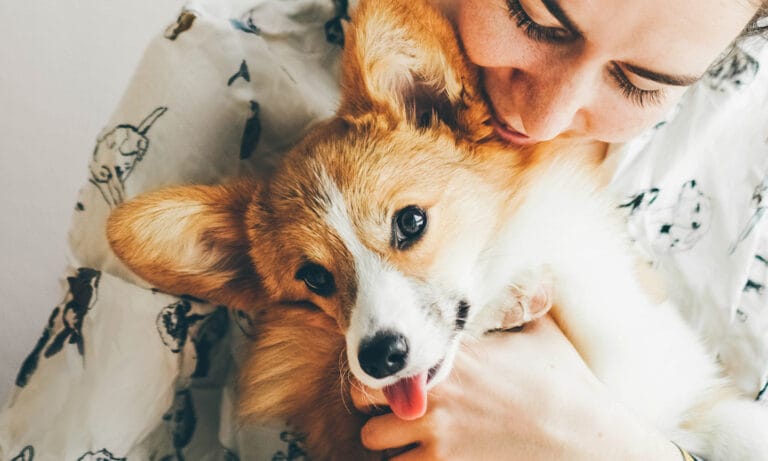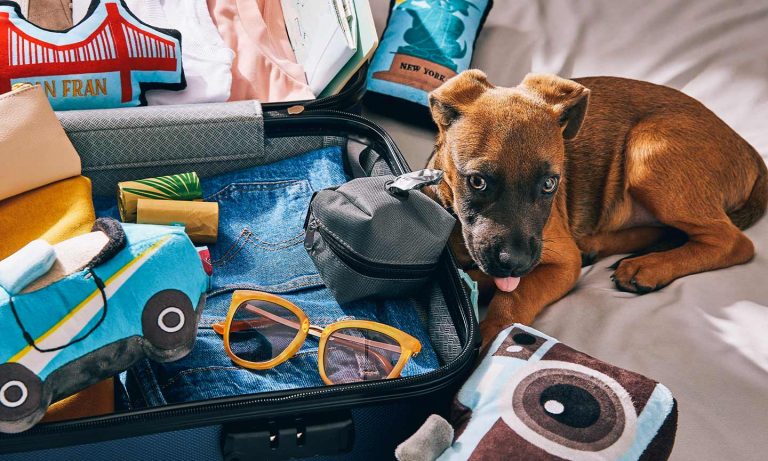“Why are newborn puppies born with their eyes shut; are their eyes still developing?” This is a common question that veterinarians are asked. Similarly, we are asked, “Aren’t dogs color-blind?” I hope to give you a brief description about some of the important senses that develop in puppies, specifically vision, hearing and olfaction (smell).
Puppy Seeing Ability
Yes, it’s true, puppies are born with their eyelids closed and “sealed.” The eyes are formed but not matured. Their eyelids remain closed for the first 10 to 16 days of life. Puppies are, to a degree, color-blind. Dogs see in a dichromatic spectrum of colors that consist mainly of blues, grays, white and pale yellows. We, on the other hand, see color as a trichromatic spectrum, which is literally all colors of the rainbow. Remember back in elementary science class the abbreviation “ROY-G-BIV?” That stood for red, orange, yellow, green, blue, indigo and violet, which are all of the colors. So, you see more colors than your puppy and you can also see better closer up. On average, your puppy has 20/75 vision, while humans (with correction, if needed) should have perfect 20/20 vision.
Your puppy will see better in the dark and also can track moving objects much better than stationary ones. Remember, dogs in the wild must hunt prey. Their eyesight is based on that premise. Their field of view is larger than ours, they have a special reflective layer in the back of the eye that allows them to see in dim light, and they have both monocular and binocular depth perception. Puppies who are 2 to 3 weeks old and older can judge distance and track fast-moving objects relatively easily. Have you ever wondered why when you throw a treat to your puppy, he chases it and gets to it within a flash; however, when you take a treat and put it on the ground, your puppy can’t find it. This is because the canine eye is very good at tracking moving objects, especially in dim light.
Puppy Hearing Ability
Unlike their eyes, which are born functional but not fully developed, puppies are born deaf. They cannot hear until 3 weeks or so of age. During this initial 2 to 3 weeks, your practically blind and deaf pup must navigate the world using scent. However, once fully developed, your puppy can hear four times the distance you can! Puppies can hear sounds in the frequency range of 60 to 60,000 Hertz can be detected by puppies while our range is only 40 to 20,000 Hz. Anything over 20,000 Hertz is considered ultrasonic. That’s why we hear nothing when a dog whistle is blown, but your puppy will cringe and cock his head to the side. However, puppies don’t hear low frequencies as well as we do. That’s why puppy toys make such loud, high-pitched squeaks.
Another adaptation that puppies have is the large number of muscles that control the ear. Can you wiggle your ears? I can’t, but my puppy can turn her ears “up” and actually turn the opening to focus on a sound. The canine ear has about 18 muscles that control its position, while we have about a third of those muscles. If your puppy has upright ears, that’s even better. Breeds with upright ears like German Shepherds can move their ears toward the direction of sound and hear better than breeds with hanging or “floppy” ears. The distance between their ears is also important. It helps them to localize a sound, and puppies with big heads do that better.
Puppy Smelling Ability
The most important sense for puppies is olfaction or the sense of smell. A dog’s sense of smell is up to 100,000 times as acute as ours. Certain breeds have even more sensitivity, like the proverbial police Bloodhound.
Olfaction is a puppy’s only major sense for the first few weeks of life. Puppies must find their siblings, mom and milk by using smell, not with vision or hearing. A large part of the puppy brain called the olfactory bulb is much larger and more developed than that of people.
Puppies also have an additional advantage regarding scent: the vomeronasal system. This is basically an additional organ that can interpret scent, and its main use is to detect pheromones. Ever wonder why puppies greet each other by sniffing each others’ backsides? It’s so pheromones made by glands around the rectum can be distinguished by the vomeronasal organ.
Puppies and dogs communicate through scent. Just wait until you start walking your puppy around the neighborhood! You’ll be lucky if you can get to the end of the driveway because, once out the front door, your puppy will sniff and snort every tree, bush and blade of grass, searching for pheromones of other animals. Marking areas with urine tells other animals, “Hey, this is my turf!” Pheromones also give much more information; it actually tells them a story of who left the scent — a male or female, what they eat, where they have been and whether they are in heat. Dogs’ sense of smell is so sensitive that puppies at the age of 4 to 6 months will be trained to search for drugs, explosive chemicals and even cancer! Yes, there are a number of researchers who were able to teach dogs to detect cancer, just by scent.
As you can see (no pun intended), your puppy sees better in low light and can track moving objects really well. While not color-blind, puppies don’t see as large a spectrum of colors and are limited to gray, blue/violet and pale yellow. Puppies are deaf at birth, but within a few months can hear ultrasonic sounds and locate noises very well. The most developed sense is that of smell or olfaction; it is a puppy’s only way of finding mom and milk the first few weeks of life.
By: Dr. Brian Roberts
Featured Image: mantosh/iStock/Thinkstock
Share:









